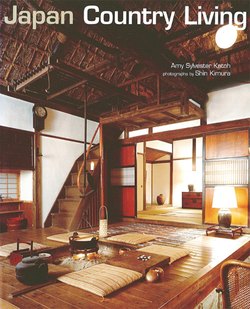Читать книгу Japan Country Living - Amy Sylvester Katoh - Страница 8
На сайте Литреса книга снята с продажи.
ОглавлениеINTRODUCTION
THE ROAD THROUGH
THE COUNTRY
On first impression, Japan was a jumble of colors, shapes, sounds, smells and people. Patches of brilliant green rice fields bordered by sluices of running water, layers of indigo mountains, explosions of scarlet spider lilies at the edges of the fields, and people in blue-and-white work clothes, planting, pruning, picking. Here and there a wooden shrine or a stone statue, graced perhaps with a red bib and a fresh offering of flowers, a rope of twisted straw, several coins. Farmhouse roofs were thatched-thick bonnets of golden reeds that turned brown, then gray. Sculpted, organic toppings, the roofs looked as though they had been poured over the house.
In the myths, the islands of Japan are said to have been created of drops falling from the spear of the founding god as it was drawn from the ocean. Standing on the hills, overlooking the misty folds of the land, the myth becomes real and I think that, yes, this must have been how Japan began. Mostly the gods created mountains. There are flat places and plains, but it is the the mountains that circumscribed and prevented man from seeing or understanding what was beyond-and also bonding people together and unifying them in common experience. In the mountains reside the spirits, the anima, that invest the earth and are objects of awe.
Today the road through the countryside of Japan is cluttered with telephone poles and wires, an avalanche of signs, posters, plastic flowers, and rusting cars, the neon flash of love hotels and the ubiquitous pachinko parlors. Everywhere there is clutter, visual chaos, the blight of consumerism on the land.
The land is a natural beauty. And the road we seek is a dream-a road that meanders through mountains and country villages of thatched houses, where people still wear indigo work clothes in the fields, with bamboo baskets beside them. The fruits of their fields are on the table in pots from nearby kilns, paper-covered lanterns light the room as they sit around an open hearth mending clothes or weaving straw sandals. Traditional country life was never easy, nor was it the rustic ideal that twentieth-century romantics try to conjure up in reply to the mechanized plastic dream world that has captured favor today. Ironically, the very prosperity that everyone welcomes is destroying the country values of resourcefulness and ingenuity and creativity, which evolved from a life of subsistence without surfeit. Until very recently in this country, life was harsh and survival difficult. The ability to make do with little and stretch possibilities to their limits allowed Japanese farmer and fisherman to endure and are the backbone of Japan's present affluence. Yet, such values seem to have no place or function in the affluent and powerful Japan of today. Something important has been lost. While poverty is hardly desirable, there should be some means of keeping alive the wisdom it engendered.
The ingenuity, vigor, and creativity of rural Japan of the past may still be found. We can dip our buckets into the waters of time, when people were forced to make what they needed to live with, to eat with, to pray and play with. By going to the countryside, by relating to and living with things made by country craftsmen, farmers, fishermen and their wives, one can touch the values that imbued Japan with vitality. Country things were made to be used. Their beauty comes from that utility and earns our admiration just because it is not trying to attract attention or be beautiful. The unassuming nature of country things is what appeals to me.
Before the old could vanish entirely, I put together this book, searching for the road least traveled, taking old paths and new, real and ideal, to create a collage that will give a taste of country Japan. Sometimes essences of the country are found in the city, or in the tiny spaces of public housing developments. Sometimes they exist in the mind. Flashes of country spirit-the unselfconscious genius of country Japan past and present, in houses, food, craft, work, and play-can be found in unexpected places. I have chosen a mixture of traditional and contemporary as well here to represent the honesty, the strength, the charm, the beauty, and the quirkiness of country Japan. Join me on this trip through a Japan little seen and little appreciated. The journey can give meaning, humor, and beauty to our own lives. It is a road once taken never forgotten, a journey that for me will never end.
